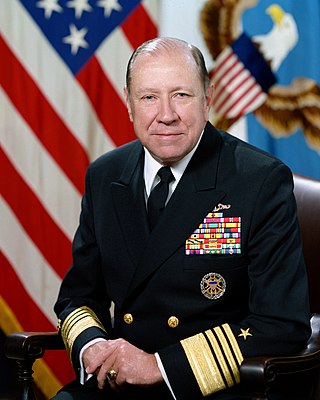
William James Crowe Jr. was a United States Navy admiral and diplomat who served as the 11th chairman of the Joint Chiefs of Staff under Presidents Ronald Reagan and George H. W. Bush, and as the ambassador to the United Kingdom and Chair of the Intelligence Oversight Board under President Bill Clinton.

Vice Admiral Robert Lee Ghormley was an admiral in the United States Navy who served as Commander, South Pacific Area during World War II. Ghormley was long considered to be an ineffective leader–overly cautious, pessimistic, and even defeatist–but recent scholarship has shown that while he may not have been an inspiring leader, he performed well under difficult circumstances.

Cameron McRae Winslow served in the United States Navy during the Spanish–American War and World War I. He was a son of Commander Francis Winslow (I) (1818–1862), who fought in the Civil War and died of yellow fever in 1862 while in command of USS R. R. Cuyler.

Vice Admiral Diego E. Hernandez was a United States Navy officer who was the first Hispanic American to be named Vice Commander, North American Aerospace Defense Command (NORAD).

United States Naval Forces Central Command (NAVCENT) is the United States Navy element of United States Central Command (USCENTCOM). Its area of responsibility includes the Red Sea, Gulf of Oman, Persian Gulf, and Arabian Sea. It consists of the United States Fifth Fleet and several other subordinate task forces, including Combined Task Force 150, Combined Task Force 158 and others.

Rear Admiral Richard Joseph Naughton was the superintendent of the U.S. Naval Academy from 2002 to 2003.
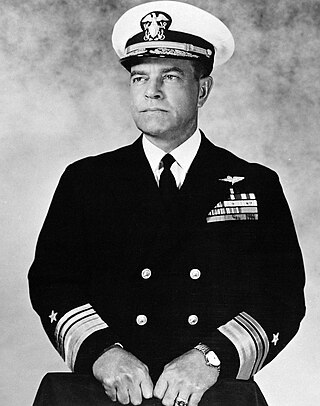
Patrick Nieson Lynch Bellinger CBE was a highly decorated officer in the United States Navy with the rank of Vice Admiral. A Naval aviator and a naval aviation pioneer, he participated in the Trans-Atlantic flight from Newfoundland to Azores in May 1919 and was decorated with Navy Cross, the United States military's second-highest decoration awarded for valor.

Felix Budwell Stump was an admiral in the United States Navy and Commander, United States Pacific Fleet from July 10, 1953 until July 31, 1958.
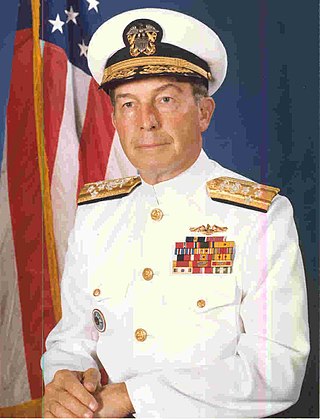
Robert Lyman John Long was a four-star admiral in the United States Navy who served as Vice Chief of Naval Operations from 1977 to 1979 and Commander in Chief Pacific from 1979 to 1983.
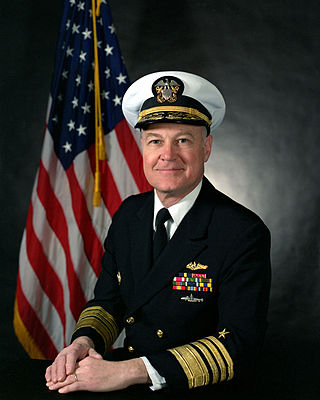
Henry Goodman Chiles Jr. is a retired United States Navy four star admiral who served as Commander in Chief, United States Strategic Command (USCINCSTRAT), from 1994 to 1996, the first naval officer to command all of the strategic nuclear forces of the United States.
Hispanics in the United States Navy can trace their tradition of naval military service to men such as Lieutenant Jordi Farragut Mesquida, who served in the American Revolution. Hispanics, such as Seaman Philip Bazaar and Seaman John Ortega, have distinguished themselves in combat and have been awarded the Medal of Honor, the highest military decoration of the United States. Hispanics have also reached the top ranks of the navy, serving their country in sensitive leadership positions on domestic and foreign shores. Among those who have reached the highest ranks in the navy are Commodore Uriah Phillips Levy, of Sephardic and Ashkenazic Jewish descent, who participated in the War of 1812 as an assistant Sailing master; Admiral David Glasgow Farragut, for whom the rank of admiral in the U.S. Navy was created during the American Civil War; and Admiral Horacio Rivero, who led the navy during the Cuban Missile Crisis.

Frank Dunn Berrien was an American football coach and United States Navy officer who served during six conflicts. He was the 13th head football coach for the United States Naval Academy located in Annapolis, Maryland and he held that position for three seasons, from 1908 until 1910. His coaching record at Navy was 21–5–3. As commanding officer of the USS Nicholson, he fought in the action of 17 November 1917 and subsequently received the Navy Distinguished Service Medal.
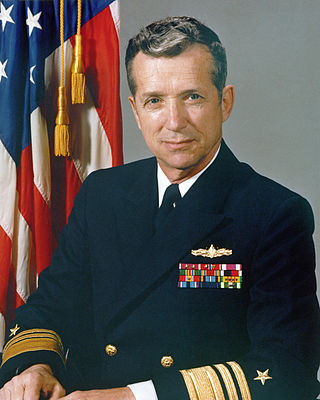
Joseph Metcalf III was a United States Navy vice admiral. He graduated from Vermont Academy in 1946 and then from the Naval Academy in 1951 and retired from active duty in 1987.

John Howard Hoover was a United States Navy admiral who held several flag commands during World War II most notably those in the Central Pacific under Chester W. Nimitz. Hoover became one of Nimitz's trusted if little known admirals of the Pacific war.

Arthur Cayley Davis was an admiral of the United States Navy. His career included service in World War II and the Cold War. He was a pioneer of dive bombing.

Robert Francis "Dutch" Schoultz was a vice admiral in the United States Navy. He was a former commander of the Naval Air Force U.S. Pacific Fleet and a former Deputy Commander in Chief of U.S. Naval Forces Europe/U.S. Commander Eastern Atlantic. He also served as Deputy Chief of Naval Operations for Air Warfare. From June 26, 1981 until his retirement on February 17, 1987, he was U.S. naval aviation's Gray Eagle, the second longest serving senior active-duty naval aviator. In retirement he became president of Rosco, Inc., an aerospace industry consulting firm, and served on the board of Reflectone Inc.

Christopher Watson Grady is a United States Navy admiral who is currently serving as the 12th vice chairman of the Joint Chiefs of Staff since December 20, 2021.

Scott Andrew Stearney was an American naval aviator and vice admiral of the United States Navy who served as commander of the Fifth Fleet based in Bahrain.

Arthur Robert Gralla was an American sailor who rose to the rank of Vice Admiral in the United States Navy.

Hugh Hilton Goodwin was a decorated officer in the United States Navy with the rank of Vice Admiral. A veteran of both World Wars, he commanded escort carrier USS Gambier Bay (CVE-73) during the Mariana Islands campaign. Goodwin then served consecutively as Chief of Staff, Carrier Strike Group 6 and as Air Officer, Philippine Sea Frontier and participated in the Philippines campaign in the later part of the War.



















